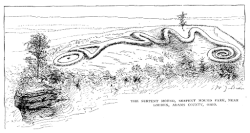| Periods in North American prehistory |
|---|
 |
In archaeological cultures of North America, the classic stage is the theoretical North and Meso-American societies that existed between AD 500 and 1200. This stage is the fourth of five stages posited by Gordon Willey and Philip Phillips' 1958 book Method and Theory in American Archaeology.[1]
Cultures of the Classic Stage are supposed to possess craft specialization and the beginnings of metallurgy. Social organization is supposed to involve the beginnings of urbanism and large ceremonial centers. Ideologically, Classic cultures should have a developed theocracy.[2]
The "Classic Stage" was initially defined as restricted to the complex societies of Mesoamerica and Peru. However, the time period includes other advanced cultures, such as Hopewell, Teotihuacan, and the early Maya.
The "Classic Stage" followed the Formative stage (Pre-Classic) and was superseded by the Post-Classic stage.[3] There are alternative classification systems, and this ranking would overlap what others classify as the Woodland period and Mississippian cultures.
- The Lithic stage
- The Archaic stage
- The Formative stage
- The Classic stage
- The Post-Classic stage
See also
[edit]- Archaeology of the Americas
- Category:Archaeology in the Americas
- Chachapoyas culture
- Cultural periods of Peru
- Mesoamerican chronology
- Olmec influences on Mesoamerican cultures
References
[edit]- ^ Willey, Gordon R. (1989). "Gordon Willey". In Glyn Edmund Daniel; Christopher Chippindale (eds.). The Pastmasters: Eleven Modern Pioneers of Archaeology: V. Gordon Childe, Stuart Piggott, Charles Phillips, Christopher Hawkes, Seton Lloyd, Robert J. Braidwood, Gordon R. Willey, C.J. Becker, Sigfried J. De Laet, J. Desmond Clark, D.J. Mulvaney. New York: Thames & Hudson. ISBN 0-500-05051-1. OCLC 19750309.
- ^ Gordon R. Willey and Philip Phillips (1957). Method and Theory in American Archaeology. University of Chicago Press. ISBN 978-0-226-89888-9.
- ^ "Method and Theory in American Archaeology". Gordon Willey and Philip Phillips. University of Chicago. 1958. Archived from the original on 2012-06-28.
External links
[edit] Media related to Classic period in the Americas at Wikimedia Commons
Media related to Classic period in the Americas at Wikimedia Commons



Well, that’s interesting to know that Psilotum nudum are known as whisk ferns. Psilotum nudum is the commoner species of the two. While the P. flaccidum is a rare species and is found in the tropical islands. Both the species are usually epiphytic in habit and grow upon tree ferns. These species may also be terrestrial and grow in humus or in the crevices of the rocks.
View the detailed Guide of Psilotum nudum: Detailed Study Of Psilotum Nudum (Whisk Fern), Classification, Anatomy, Reproduction